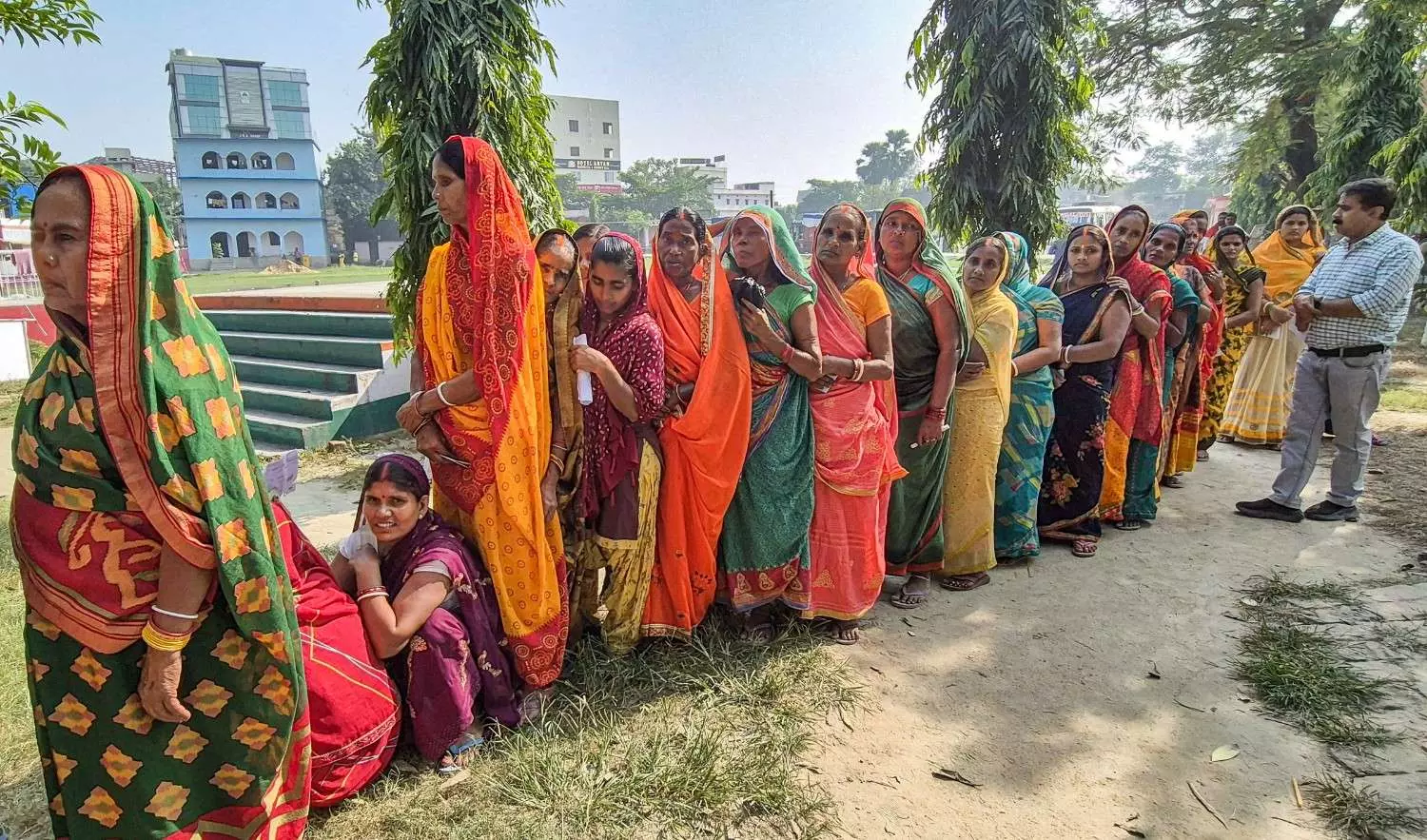
Women voters wait in a queue to cast votes at a polling station during the first phase of the Bihar Assembly elections, at Hajipur in Vaishali, Thursday, November 6. PTI
Bihar polls: Record voter turnout of nearly 65 pc in phase 1
The Election Commission said the first phase of the Assembly elections concluded peacefully "in a festive mood with the highest ever voter turnout of 64.66 per cent in the history of Bihar"

In the "highest ever" voter turnout in Bihar, nearly 65 per cent of 3.75 crore electors voted on Thursday (November 6) across 121 constituencies in the first phase of the Assembly polls.
In a statement, the Election Commission (EC) said the first phase of the Assembly elections concluded peacefully "in a festive mood with the highest ever voter turnout of 64.66 per cent in the history of Bihar".
Women come out in large numbers
Chief Electoral Officer (CEO) Vinod Singh Gunjiyal said women came out in large numbers to cast their votes, with "a lot of enthusiasm".
Also read: Live updates of Bihar polls
Reacting to the high voter turnout, the BJP, RJD, Congress and Jan Suraaj claimed that it was indicative of their respective victories.
RJD leader Tejashwi Yadav, the INDIA bloc's chief ministerial candidate, said, "I salute the people of Bihar for the bumper voting. I can now confidently say you have affirmed the victory of 'Mahagathbandhan'".
Senior BJP leader and Deputy CM Samrat Choudhary told a press conference, “We are going to win about 100 of the seats which went to polls today. The overall tally for the NDA will surpass the 2010 record of 206 seats”.
Also read: Priyanka Gandhi says NDA will be ousted from Bihar if polls are free and fair
Jan Suraaj Party founder Prashant Kishor claimed the highest voter turnout was a sign of the people's yearning for a change. "After November 14, when votes will be counted, Bihar will have a new regime".
Congress confident of win
Congress' Pawan Khera said the high voter turnout suggests we are going to get a clear majority.
The NDA, which has been in power in the state for 20 years, except for a few brief interruptions, is banking on its image of "sushasan" (good governance) in contrast to the alleged "jungle raj" of the RJD-Congress combine, while the Opposition bloc relies on anti-incumbency and the unprecedented "jobs-for-every-home" promise to outperform the ruling alliance.
The polls for the 243-member Assembly are being closely watched not only for their local implications but also as an early indicator of the political mood ahead of 2029, and follow the highly controversial Special Intensive Revision (SIR) of the electoral rolls by the EC, which came under attack from Opposition parties for alleged "rigging" and "manipulation" of voter lists.
The second and the last phase will be held on November 11, and the counting will take place on November 14.
Stakes are high for both the ruling NDA and the Opposition INDIA bloc, with several key leaders, including RJD's Yadav, Deputy CMs Choudhary and Vijay Kumar Sinha, besides a slew of ministers, being among the 1,314 candidates in fray in this phase.
Stray incidents of violence, including an alleged attack on Sinha's vehicle, were reported from some areas during the polling.
Polling was held across 18 districts, with Muzaffarpur and Samastipur recording the highest turnouts, as per the latest available data.
Muzaffarpur tops
Muzaffarpur recorded a turnout of 70.96 per cent, while the polling percentage in Samastipur stood at 70.63. Madhepura recorded 67.21 per cent turnout, followed by Vaishali at 67.37 per cent, Saharsa at 66.84 per cent, Khagaria at 66.36 per cent, Lakhisarai at 65.05 per cent, Munger at 60.40 per cent, Siwan at 60.31 per cent, Nalanda at 58.91 per cent, and Patna at 57.93 per cent.
According to the EC, the Assembly elections of 1951-52 saw the lowest voter turnout in the state at 42.6 per cent, while the one in 2000 saw the highest turnout before this, at 62.57 per cent.
In 2020, held under the shadow of the COVID-19 pandemic, a voter turnout of 57.29 per cent was recorded, while in 2015, it was 56.91 per cent, and 52.73 in 2010.
(With agency inputs)

